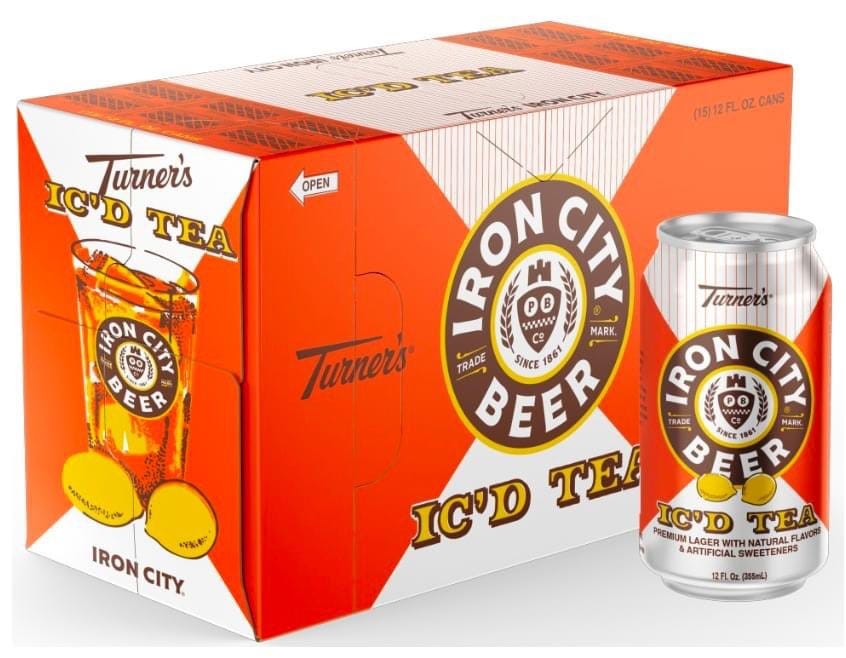Three industry topics that always get me excited include 1) Cross-industry collaborations, 2) 19.2oz cans, and 3) Craft Beer’s place in professional sports. Each got my attention this past week in the news and on social media so here’s a round-up and some reactions:
Iron City Beer xx Turner’s: IC’d Tea
Boston Beer’s Twisted Tea product has proven over the years that spiked tea has a big market, especially outside of cities. This has caused many bevalc companies to explore the hard tea space and shortly after arriving in Pittsburgh for a family getaway, I came across this brilliant announcement. Iron City is collaborating with the iconic, local Iced Tea brand Turner’s to release IC’d Tea. The name is a play on Iron City’s name, which is abbreviated on their light beer option, IC Light. While Turner’s (est. 1972) can’t compete with with Iron City’s history dating back to 1861, both hit all the local and nostalgia vibes for Yinzer’s of all drinking ages.
Having worked on a (sort of) similar collaboration last year between Revolution Brewing & Garrett Popcorn, I can say that these projects addd a lot of value outside the obvious sales and public relations lift. The amount of discussions and meetings it takes between the two different companies, each with their own priorities and processes, to build and launch a co-branded product like this provides a unique learning experience for all involved. The added complexity leads to a leveled up skillset and more well-rounded knowledge of the wider CPG industry.
I was lucky enough to give a presentation to Pittsburgh’s MBAA members this week and during my conversations afterwards, it was fascinating to hear so much enthusiasm for this product from small brewery members. It sounds like Pittsburgh Brewing Co., producers of the Iron City brands, are the senior member of the local scene and serve as a sort of big brother/sister to the smaller breweries in the area. You love to see it.
Austin Beer Works: Y’allboy
I love the interesting market proposition that 19.2oz cans posed. One of my favorite blog posts I ever wrote was called The Skinny on Tallboys, which is a deep dive into the packaging size that’s remained a fairly evergreen post 4 years later. Historically, this format is used to help build established brands in the convenience channel, widening the consumer net for future adoption and growth. Austin Beerworks, a pillar of the Austin craft beer scene and beloved participant in daily conversations on #BeerTwitter, has teased out a different approach to branding this format.
Rather than using the increased real estate provided by a 19.2oz can to scream Pearl-Snap, their German-Style Pils, they’ve given their entry to this format it’s own nickname: Y’allboy, a riff on “Tall Boy”. While this approach doesn’t do as much to elevate Pearl-Snap specifically, it creates a branded occasion that has viral potential in their local market. While I didn’t bother asking cause I prefer to speculate, I would assume that you don’t invent the Y’allboy format unless you’re planning for at least 2-3 brands. I would expect other brands of Y’allboys to look very similar, with colors changed out, and the brand names swapped. This is fun and leans into the extra casual nature that tends to surround a 19.2oz beer occasion.
“Will MLB's new pitch clock chip away at beer sales in ballparks?” ~Kate Bernot
Kate is one of the best beer writers in the country and always comes up with great questions before I even realize I want to know the answer to them. This thoughtful reporting caught my eye this week as I’ve long been a critic of the length of baseball games, yet have been invested in beers sales at the stadium through my role in marketing.
The article has an overall theme that connects well to the centerpiece of some presentations that I’ve been working on lately related to marketing in beer. Like the game of baseball, craft beer needs to make more investments that don’t necessarily payoff immediately. Instead, the benefits compound leading to long term, sustainable health. While on the surface, shorter games could technically mean less beers sold in person at games per person, if growth in interest in the game is able to reverse course, we’ll see more viewers on TV and attendance numbers return to growth. With most attendees having a fairly fixed number of beers that they’ll drink regardless of the length of the game, these investments should only help beer sales in the long term. Check out Kate’s piece for the full story.








Interesting article and thoughts on the speed clock. Would never have thought of that.
Y'allboy Variety Pack!!!